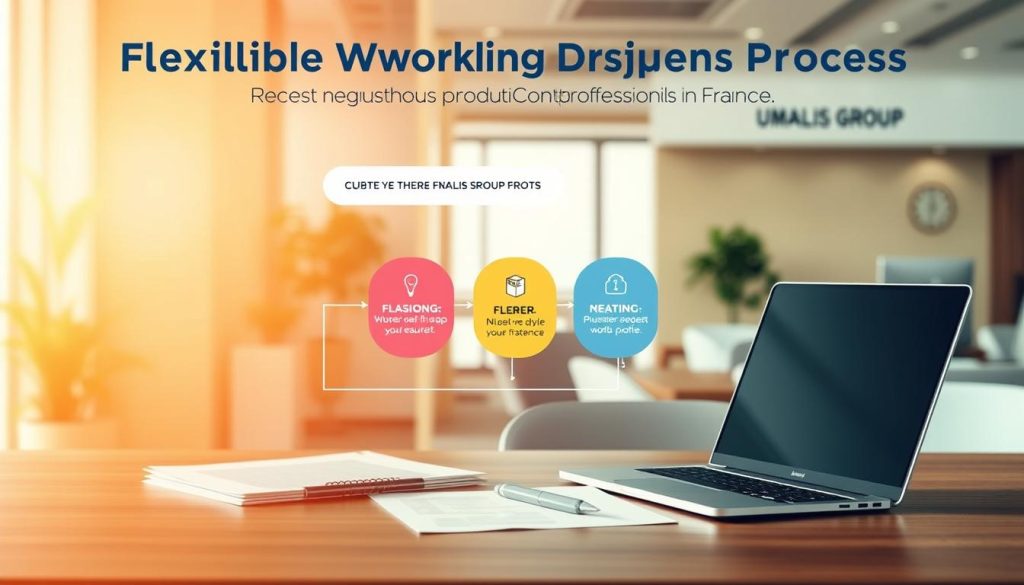Achieving a balance between professional and personal life is a continuous challenge for many professionals. As the modern workplace evolves, adapting to new work arrangements has become essential for maintaining this balance.
For professionals in France and around the world, flexible working arrangements can be a game-changer, enabling them to better manage their work and personal responsibilities. An employer that supports such arrangements can significantly enhance an employee’s overall well-being and productivity.
When considering a request for flexible working, understanding the various options available and the legal framework that governs them is crucial. This guide will explore the different types of flexible working, including remote work and flexible hours, and provide insights into successfully implementing these arrangements.
Table of Contents
Key Takeaways
- Flexible working can significantly improve work-life balance for professionals.
- Various flexible working arrangements are available, including remote work and flexible hours.
- Understanding the legal framework is essential when making a request for flexible working.
- Employers play a crucial role in supporting flexible working arrangements.
- Flexible working can lead to enhanced productivity and employee well-being.
Understanding Flexible Working in Today’s Professional Landscape
Flexible working has become a cornerstone in today’s professional world, offering numerous benefits for both employees and employers. It encompasses a wide range of working patterns that deviate from the traditional 9-to-5 office-based model, allowing professionals to adapt their work to better suit their individual needs and circumstances.
What Defines Flexible Working Arrangements
Flexible working arrangements are characterized by the element of choice, giving employees greater control over when, where, and sometimes how they complete their work responsibilities. Common types of flexible working include:
- Part-time work
- Flexi-time
- Annualized hours
- Compressed hours
- Staggered hours
- Job sharing
- Working from home
These arrangements allow employers to cater to the diverse needs of their workforce, potentially leading to increased job satisfaction and productivity.
The Evolution of Workplace Flexibility
The concept of flexible working has evolved significantly over recent decades, transitioning from an occasional perk to a mainstream work practice. This evolution has been driven by technological advancements, changing social attitudes, and more recently, the global pandemic, which forced organizations to rapidly adapt to remote working models.
Today’s professional landscape recognizes flexible working not merely as an employee benefit but as a strategic business approach that can drive productivity, engagement, and talent retention. As such, flexible working is no longer seen as a deviation from the norm but rather as a standard aspect of modern work life.
Types of Flexible Working Arrangements
The modern workplace is evolving, with various flexible working arrangements emerging to cater to the diverse needs of professionals. This shift is driven by the need for better work-life balance, increased productivity, and job satisfaction.
Remote and Hybrid Work Models

Remote and hybrid work models have become increasingly prevalent, allowing professionals to work entirely from home or alternate between home and office environments. This flexibility reduces commuting time while maintaining collaborative opportunities.
Flexible Hours and Schedules
Flexible hours and schedules enable employees to adjust their start and finish times around core business hours, accommodating personal commitments while ensuring operational coverage. This arrangement is particularly beneficial for professionals with caregiving responsibilities.
Compressed Workweeks and Job Sharing
Compressed workweeks involve working the standard number of hours over fewer days, such as a four-day week with longer daily hours. Job sharing arrangements allow two professionals to split the responsibilities of a single full-time position, offering reduced hours while ensuring continuous coverage of the role.
Annualized Hours and Other Arrangements
Annualized hours systems calculate work time over a full year rather than weekly, allowing for seasonal variations in workload and providing flexibility during quieter periods. Other innovative arrangements include term-time working, phased retirement, and career breaks, designed to accommodate different life stages and personal circumstances.
By adopting these flexible working arrangements, professionals can achieve a better balance between their work and personal life, leading to improved overall well-being and job satisfaction.
The Benefits of Flexible Working for Professionals

The benefits of flexible working for professionals are multifaceted, ranging from improved work-life balance to enhanced productivity. Flexible working arrangements provide professionals with greater control over their schedules, allowing them to better balance work responsibilities with personal commitments and family obligations.
Improved Work-Life Balance and Well-being
Flexible working enables professionals to manage their personal and professional lives more effectively. By having the flexibility to work during their most productive hours, professionals can avoid distractions and achieve higher output. As stated by a recent study, « Employees who have flexible work arrangements often report higher levels of job satisfaction and are more likely to remain with their employers long-term. »
« Employees who have flexible work arrangements often report higher levels of job satisfaction and are more likely to remain with their employers long-term. »
Enhanced Productivity and Job Satisfaction
The ability to work during personally optimal hours can significantly enhance productivity, as professionals can align their most demanding tasks with their peak energy and focus periods. Flexible working arrangements lead to increased productivity and help reduce absenteeism by allowing employees to work from home when they are sick or need to care for family members.
Reduced Commuting Time and Costs
Reduced commuting time not only saves money on transportation costs but also decreases stress and fatigue, contributing to improved overall well-being and mental health. Professionals with flexible working arrangements often report higher job satisfaction and engagement, feeling valued and trusted by employers who recognize their need for autonomy.
By embracing flexible working, professionals can create a more sustainable approach to long-term career development, managing personal appointments, family responsibilities, and unexpected emergencies without taking full days off work.
Advantages for Employers Embracing Flexible Working
The shift towards flexible working is not just beneficial for employees; it also offers significant advantages for employers. As the modern workplace continues to evolve, adopting flexible working arrangements can be a strategic move for businesses looking to stay competitive and responsive to the needs of their workforce.
Talent Attraction and Retention Benefits
Flexible working arrangements can be a key differentiator in attracting top talent, particularly among younger generations who prioritize work-life balance. By offering flexible working options, organizations gain a competitive advantage in the job market, improving employee retention rates and reducing recruitment costs. This approach allows employers to preserve institutional knowledge and maintain a skilled workforce.
Cost Savings and Operational Efficiencies
Implementing flexible working can lead to significant cost savings for employers. Reduced office space requirements and lower utility expenses contribute to these savings. Moreover, flexible working arrangements can decrease absenteeism and improve productivity, further enhancing operational efficiencies. Employers can also benefit from extended operational hours when employees work on flexible schedules, potentially improving customer service and global collaboration.
Building a More Diverse and Inclusive Workplace
Flexible working enables businesses to build more diverse and inclusive workforces. By accommodating the needs of parents, caregivers, people with disabilities, and those with various religious or cultural commitments, employers can create a more inclusive work environment. This approach not only enhances the organization’s reputation but also fosters a positive and supportive workplace culture.
| Benefits for Employers | Description | Impact |
|---|---|---|
| Talent Attraction | Flexible working options attract top talent | Competitive advantage in the job market |
| Cost Savings | Reduced office space and utility expenses | Significant cost reductions |
| Diversity and Inclusion | Accommodating diverse employee needs | More inclusive work environment |
By embracing flexible working, employers can not only improve their operational efficiencies and attract top talent but also create a more diverse and inclusive workplace. As highlighted in our discussion on finding the right employment agency, flexible working arrangements are becoming increasingly important in today’s professional landscape.
How to Request Flexible Working Arrangements
Requesting flexible working arrangements can be a significant step for professionals looking to achieve a better work-life balance.The key to a successful flexible working request lies in understanding your organization’s policies and presenting a well-structured application. This involves several crucial steps that can significantly improve your chances of a favorable response from your employer.
Preparing a Compelling Flexible Working Request
To begin, thoroughly research your organization’s policies and procedures regarding flexible working arrangements. Many companies have formal processes in place for handling such requests. When preparing your application, clearly articulate the specific arrangement you’re seeking, including precise details about hours, location, and proposed start date for the new working pattern.
Frame your request in terms of business benefits rather than personal needs, highlighting how the arrangement could enhance your productivity, availability during critical hours, or other positive impacts on the organization. For instance, you could emphasize how flexible working can lead to increased job satisfaction and reduced turnover rates.
The Formal Application Process
When making an application, it must be made well in advance of when you want it to take effect, be in writing (as a letter or email), and be dated. Your application should state that it is made under the statutory right to request a flexible working pattern, provide details of the flexible working pattern you’re applying for (including the date from which you want it to start), and explain what effect you believe the new working pattern would have on your employer and how any such effect might be dealt with.
| Application Component | Description | Example |
|---|---|---|
| Flexible Working Pattern Details | Specify the type of arrangement and its implementation details | « I propose working from home three days a week, starting from January 1st. » |
| Impact on Employer | Explain how the new pattern may affect the employer and suggest solutions | « I will ensure that my tasks are completed on time and be available during core hours for collaboration. » |
| Previous Applications | State whether you have made a previous application and when | « This is my first application for flexible working. » |
Negotiating and Compromising Effectively
Be prepared to negotiate and compromise, having alternative arrangements in mind if your ideal scenario isn’t feasible from the employer’s perspective. Consider suggesting a trial period to demonstrate the viability of your proposed arrangement, which often makes employers more comfortable approving requests they might otherwise view as risky.
Legal Framework for Flexible Working in France

Employees in France have the right to request flexible working arrangements, a right that is supported by a clear legal framework. This framework is designed to ensure that employees can achieve a better balance between their work and personal life while considering the needs of their employers.
Understanding Your Rights as an Employee
As an employee, you have the right to request flexible working, but it’s essential to understand that this is a right to request, not an automatic right to receive the requested arrangement. Your employer is required to consider your application seriously and reject it only for reasonable business reasons. This includes grounds such as additional costs, detrimental effects on customer service, or inability to reorganize work among existing staff.
- The law protects employees from discrimination, ensuring that requests from parents, caregivers, or employees with disabilities receive appropriate consideration.
- Understanding the appeal process is crucial, as employees have the right to challenge decisions they believe were made without proper consideration or based on incorrect information.
Employer Obligations and Permitted Refusal Grounds
Employers must consider all flexible working requests seriously and respond within specific timeframes, typically within two months. They can only refuse requests based on legitimate business grounds, which include burden of additional costs, detrimental effect on customer demand, inability to reorganize work, and planned structural changes.
When refusing a request, employers must provide written justification, citing specific business reasons. This ensures transparency and helps employees understand the decision-making process.
Implementing Successful Flexible Working Practices
Implementing flexible working effectively requires a multifaceted approach that includes clear communication, the right technology, and a focus on outcomes. As employers look to adopt flexible working arrangements, several key considerations come into play to ensure success.
Setting Clear Expectations and Boundaries
Successful implementation of flexible working begins with establishing clear expectations regarding availability, responsiveness, and deliverables. This ensures alignment between employer and employee understanding. Creating explicit boundaries between work and personal time is especially important when working from home.
Effective Communication Strategies
Effective communication strategies are crucial, including regular check-ins, appropriate use of various communication channels, and protocols for urgent matters to maintain team cohesion. Employers must invest in creating a culture that supports open and transparent communication.
Technology and Tools for Flexible Working

Investing in the right technology and tools is essential, including secure remote access solutions, collaboration platforms, and project management software. Employers should equip employees with the necessary technology to work effectively from remote locations.
Measuring Performance in Flexible Arrangements
Performance measurement should shift from time-based to outcome-based metrics, focusing on results and deliverables rather than hours worked or physical presence. This approach ensures that employees are judged on their productivity and output.
By implementing these strategies, employers can create a flexible working environment that benefits both the organization and its employees. Regular reviews of flexible working arrangements allow for adjustments based on changing business needs and individual circumstances.
Conclusion: Creating a Sustainable Flexible Working Culture
As we navigate the evolving landscape of professional work, creating a sustainable flexible working culture emerges as a critical factor for success. Organizations that embrace this shift are better positioned to attract top talent, enhance employee engagement, and drive business resilience.
To achieve this, it’s essential to strike a balance between individual autonomy and team cohesion. Effective flexible working arrangements ensure that personal flexibility doesn’t compromise collaboration and organizational alignment. Leadership plays a vital role in modeling appropriate behaviors, demonstrating that career advancement is possible while utilizing flexible arrangements.
Regular review and adaptation of flexible working policies are crucial. This involves gathering feedback from employees and staying informed about emerging best practices, technological innovations, and legal developments. Trial periods can be valuable in testing new arrangements before making permanent changes.
The future of work will likely see an even greater emphasis on flexibility. Organizations that adapt effectively will gain significant advantages in talent attraction, employee engagement, and business resilience. By creating a culture that supports flexible working, employers can reap mutual benefits, enabling professionals to achieve a better work-life balance while building more agile, diverse, and productive workforces.
Ultimately, flexible working is not just a benefit but a strategic business approach that requires ongoing commitment from both employers and employees. By embracing this approach, organizations can thrive in an ever-changing business landscape.
FAQ
What is the process for requesting a change in my work schedule?
To request a change in your work schedule, you should submit a formal application to your employer, outlining the changes you are seeking and the reasons behind your request. Your employer is required to consider your application and respond within a specified timeframe.
Can my employer refuse my request for a flexible work arrangement?
Yes, your employer can refuse your request, but they must provide a valid reason for doing so. The grounds for refusal are typically related to the needs of the business, such as the impact on workload, costs, or operational requirements.
How long does my employer have to respond to my request?
Your employer is expected to respond to your request within a few months. The exact timeframe may vary depending on the specific regulations in place.
Can I request a trial period to test a new work arrangement?
Yes, it is possible to request a trial period to test a new work arrangement. This can be a useful way to assess the feasibility of the arrangement and make any necessary adjustments before committing to it long-term.
What are the benefits of adopting a flexible work arrangement for my career?
Adopting a flexible work arrangement can have numerous benefits for your career, including improved work-life balance, increased productivity, and enhanced job satisfaction. It can also provide you with more autonomy and control over your work schedule.
How can I ensure that my work arrangement is successful and meets the needs of both me and my employer?
To ensure the success of your work arrangement, it’s essential to establish clear expectations and boundaries, maintain effective communication, and regularly review the arrangement to make any necessary adjustments.
Are there any specific tools or technologies that can support my flexible work arrangement?
Yes, there are various tools and technologies available that can support your flexible work arrangement, such as project management software, time tracking tools, and virtual communication platforms. These can help you stay organized, connected with your team, and productive while working remotely or on a non-traditional schedule.





